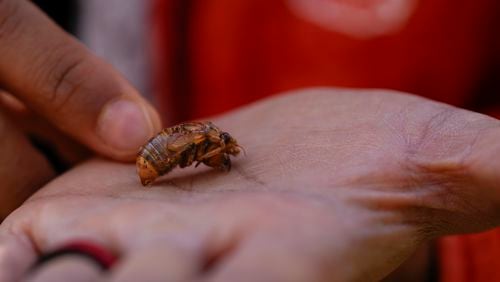Depending on the species, wingless nymph forms of cicadas can live underground feeding on the sap of tree roots for a year, 13 years or 17 years. When they emerge above ground they shed their exoskeletons, which are often found stuck on the sides of tree trunks, and insects take flight to the tops of trees. Males make courting sounds to attract females. After mating, the males soon die. The females lay their eggs under the bark of twigs on trees, then the moms die, too. Within a few days, tiny nymphs, each smaller than a grain of rice, emerge and fall to the ground. They burrow underground to begin a new cycle.
How to tell the difference between periodical cicadas (13- or 17-year) and cicadas that emerge annually during the summer:
If a cicada is above ground before June in Georgia, odds are it is a periodical cicada, according to Nancy Hicks, a professor of entomology with the University of Georgia. She said periodical cicadas have red eyes, black bodies and clear wings highlighted with orange and are often about one and a quarter inch to one and a half inch long, including their wings. Annual cicadas often have black eyes, green bodies and clear wings highlighted with green, and are usually about a half inch longer than periodical cicadas. The courting sounds of different types of cicadas can often differ, too.
Map of different cicada broods and their timing in the United States: https://www.fs.usda.gov/foresthealth/docs/CicadaBroodStaticMap.pdf (This map shows a less-expansive range for Brood XIX in Georgia than what UGA’s Nancy Hinkle has found here.) Source: U.S. Forest Service
-Compiled by Matt Kempner






